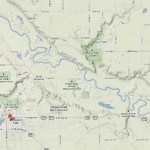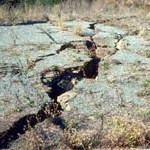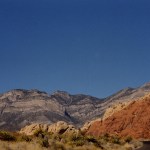Geology
Look at this map, of a small part of the state of Minnesota:
See the wide channel that runs from left to right with the windy river in it? You are looking at one of the most amazing stories in geological history ever. I'd like to tell you about it.
When not in flood, the meandering river is little more than a slow moving stream in a wide marsh, with thickets and stands of pioneer trees dispersed among reeds and pools of open water. Largely bypassed by farm, rural and urban development, it is in this channel that the state's rare cougars live, and where some of the best birding in the…
The Book of Exogenesis: In the beginning was the word, and the word was a meteorite...
Earlier this month, a report, based on NASA studies of meteorites found on Earth, suggested that some building blocks of DNA may have been formed in space.
As it turns out, DNA components have been found on meteorites before, but it's never been entirely clear if the space rocks came to Earth bearing these molecules, or if they were contaminated upon arrival. Furthermore, this recent study of meteorites was the first to discover trace amounts of three molecules -- purine, 2,6-diaminopurine, and 6,8-…
By Dr. Friedemann Freund; Carl Sagan Center for the Study of Life in the Universe, SETI Institute, and Gail Jacobs
Friedemann Freund doesn't shrink from taking on the really big problems. His research has elucidated such important phenomena as the fact that rocks under stress behave like batteries that can produce currents deep within the crust of the Earth. These are not piddling electron flows, either - the currents could be as large as millions of amperes, sufficient to be measured above ground, and perhaps even from orbit. Understanding and exploiting this phenomenon could lead to a…
The law of superimposition says that stuff found on top is younger than stuff found lower down, in a geological or archaeological column. This is generally true, but there are exceptions, mostly trivial and easily understood. If a cave forms in a rock formation, the stuff that later ends up in that cave is younger in depositional age than the rock underneath which it rests (the rock in the roof of the cave, and above).
One of the coolest examples of what seems to be (but really is not) a violation of this Law of Geology is a thrust fault. A thrust fault is essentially a horizontal fault (…
tags: Zircons: Time Capsules from the Early Earth, science bulletins, geology, AMNH, American Museum of Natural History, hadean eon, zircon, rocks, age of the earth, history of planet earth, streaming video
Zircons are tiny crystals with a big story to tell. Some of these minerals are the oldest Earth materials ever discovered, and therefore yield clues about what the planet was like after it formed 4.5 billion years ago. In this new Science Bulletins video, travel to a remote island off Greenland's coast and a zircon-making lab in New York State to learn how geologists are using these time…
Where I grew up, lakes were important. We would spend considerable time driving to them, and once there, camp next to them for a couple of weeks. Every now and then we'd go and camp next to the really really big lake. The one with England on the other side, or so my brother would tell me. All the lakes had these big chairs along the swimming areas that lifeguards sat in. The really really big lake had extra tall chairs. I remember thinking that they could probably see England from up there!
But despite the importance of lakes in our recreational regime, lakes were actually fairly…
Rock formations near the "Natural Bridge" turnout in Bryce Canyon National Park, Utah..
Photographed in Grand Staircase-Escalante National Monument, Utah.
Welcome Maryn McKenna and her blog Superbug to Sb! And, in case I forgot to mention it before, make sure to check out Deborah Blum's blog Speakeasy Science, too!
Wildlife experts use civetone-containing cologne to lure big cats
In a scene reminiscent of the ending of Kingdom of the Spiders, caterpillars blanket the English countryside with webs.
Coming soon, Inside Nature's Giants, series two.
John Lynch shares the introduction to Follies of the Present Day: Scriptural Geology from 1817 to 1857.
So you want to be a scientist? Learn to write!
How to make a blockbuster - the…
Just a few of the many hoodoos which can be seen in Bryce Canyon National Park, Utah.
Grosvenor Arch, photographed in Grand Staircase-Escalante National Monument, Utah.
It has come to my attention that a number of people are risking catastrophic seismic activity today by exposing n00bs.
This so-called "n00bquake" frightens me, and not just because I live in earthquake country.
If the internet is flooded with n00bs today, the consequences could be tragic.
We face the spectacle of people hot-linking images on other people's servers -- and then, when admonished, asking what sausages have to do with anything;
Of putting their names or handles at the end of their posts even when their usernames automatically appear beside their posts -- like there's no…
My Very Excellent Mother Just Served us Nine Pizzas.
My Very Easy Method Just Speeds Up Naming Planets.
My Very Early Morning Jam Sandwiches Usually Nauseate People.
Mon Vieux Tu M'as Jeté Sur Une Nouvelle Planète!
-- Various mnemonic devices for remembering the order of the nine planets
I just found out that Mercury is shrinking.
The planet, already our most diminutive neighbor, has lost around 3 miles of its 3,000 mile diameter in its life, or one tenth of one percent.This may not sound like much, but in geological terms, three miles is immensely significant.
This boggling fact was…
Remains of street sign embedded in pahoehoe lava flow.
Chain of Craters Road, Volcanoes National Park, Hawaii
4 November 2006
1/60 sec @ f/5.6; 55mm focal length
Technorati Tags: blogpix, lava, volcanoes national park
The view from behind Jackson Lodge in Grand Teton National Park, Wyoming.
Well, not really.
But, as noted in Eruptions, there is a new swarm of little earthquakes underneath the Yellowstone Caldera. You'll remember we discussed this here last time that happened. Since that time, of course, we've gotten to see what it would actually look like if the world's scariest caldera (maybe) actually went off:




